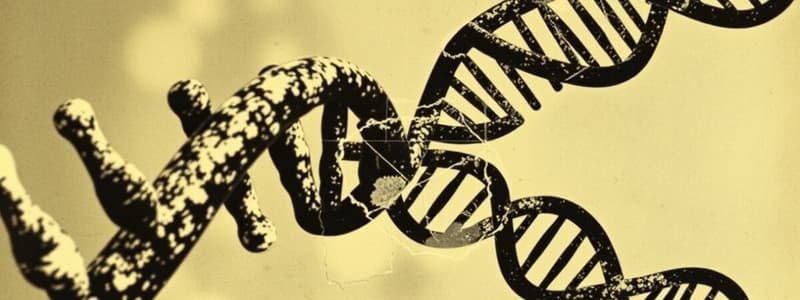Podcast
Questions and Answers
What does semiconservative mean in DNA replication?
What does semiconservative mean in DNA replication?
Each new double helix consists of one old and one new strand.
What is the function of helicase in DNA replication?
What is the function of helicase in DNA replication?
It untwists the double helix and separates the two DNA strands.
What process repairs damage to a preexisting double helix?
What process repairs damage to a preexisting double helix?
Nucleotide excision repair.
In nucleotide excision repair, damaged DNA is excised by what enzyme(s)?
In nucleotide excision repair, damaged DNA is excised by what enzyme(s)?
What are the repetitive DNA sequences present at the ends of eukaryotic chromosomes called?
What are the repetitive DNA sequences present at the ends of eukaryotic chromosomes called?
What are chromosomes made of?
What are chromosomes made of?
DNA during interphase exists as chromatin and is less condensed than mitotic chromosomes.
DNA during interphase exists as chromatin and is less condensed than mitotic chromosomes.
What is a difference between a DNA and an RNA molecule?
What is a difference between a DNA and an RNA molecule?
Which nitrogenous base is found in DNA but not in RNA?
Which nitrogenous base is found in DNA but not in RNA?
In a nucleotide, the nitrogenous base is attached to the sugar's _____ carbon and the phosphate group is attached to the sugar's _____ carbon.
In a nucleotide, the nitrogenous base is attached to the sugar's _____ carbon and the phosphate group is attached to the sugar's _____ carbon.
Nucleic acids are assembled in the _____ direction.
Nucleic acids are assembled in the _____ direction.
In a DNA double helix, an adenine of one strand always pairs with a(n) _____ of the complementary strand, and a guanine of one strand always pairs with a(n) _____ of the complementary strand.
In a DNA double helix, an adenine of one strand always pairs with a(n) _____ of the complementary strand, and a guanine of one strand always pairs with a(n) _____ of the complementary strand.
Short segments of newly synthesized DNA are joined into a continuous strand by ____.
Short segments of newly synthesized DNA are joined into a continuous strand by ____.
After DNA replication is completed, _____.
After DNA replication is completed, _____.
The first step in the replication of DNA is catalyzed by _____.
The first step in the replication of DNA is catalyzed by _____.
The action of helicase creates _____.
The action of helicase creates _____.
Why is the new DNA strand complementary to the 3' to 5' strand assembled in short segments?
Why is the new DNA strand complementary to the 3' to 5' strand assembled in short segments?
The synthesis of a new strand begins with the synthesis of a(n) _____.
The synthesis of a new strand begins with the synthesis of a(n) _____.
An old DNA strand is used as a _____ for the assembly of a new DNA strand.
An old DNA strand is used as a _____ for the assembly of a new DNA strand.
Flashcards are hidden until you start studying
Study Notes
DNA Replication
- DNA replication is semiconservative, meaning each new double helix consists of one old strand and one newly synthesized strand.
- Helicase is the enzyme that untwists the double helix and separates the DNA strands during replication.
- The process of nucleotide excision repair is responsible for repairing damage to preexisting DNA double helices.
Enzymes in DNA Repair
- Nucleases are the enzymes that excise damaged DNA during nucleotide excision repair.
Chromosome Structure
- Eukaryotic chromosome ends contain repetitive DNA sequences known as telomeres.
- Chromosomes are composed of DNA and proteins, which play crucial roles in structure and function.
DNA vs. RNA
- During interphase, DNA exists as chromatin, which is less condensed than mitotic chromosomes.
- A key difference between DNA and RNA is that DNA is double-stranded while RNA is typically single-stranded.
- Thymine is a nitrogenous base found in DNA but not in RNA.
Nucleotides
- In a nucleotide, the nitrogenous base attaches to the sugar's 1' carbon, while the phosphate group is linked to the sugar's 5' carbon.
- Nucleic acids are synthesized in the 5' to 3' direction, which is crucial for their formation.
Base Pairing
- In a DNA double helix, adenine pairs with thymine and guanine pairs with cytosine on the complementary strand.
DNA Synthesis
- Short segments of newly synthesized DNA are joined into a continuous strand by the enzyme ligase.
- After replication, each new DNA double helix comprises one old and one new DNA strand.
- The initial step in DNA replication is catalyzed by helicase, creating replication forks and bubbles.
Directionality of Synthesis
- The new DNA strand opposite the 3' to 5' strand is assembled in short segments due to the restriction of DNA polymerase, which can only synthesize DNA in the 5' to 3' direction.
- The synthesis of a new strand begins with an RNA primer that is complementary to the existing DNA strand.
- An old DNA strand serves as a template for the assembly of the new DNA strand, guiding the replication process.
Studying That Suits You
Use AI to generate personalized quizzes and flashcards to suit your learning preferences.



